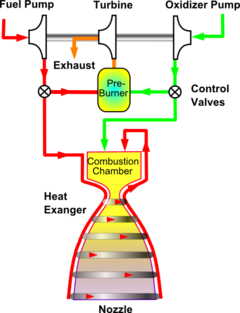
Gas-generator cycle (rocket)
Encyclopedia

Engine
An engine or motor is a machine designed to convert energy into useful mechanical motion. Heat engines, including internal combustion engines and external combustion engines burn a fuel to create heat which is then used to create motion...
. Some of the propellant is burned in a gas-generator and the resulting hot gas is used to power the engine's pumps. The gas is then exhausted. Because something is "thrown away" this type of engine is also known as open cycle.
There are several advantages to the gas generator cycle over its counterpart, the staged combustion cycle
Staged combustion cycle (rocket)
The staged combustion cycle, also called topping cycle or pre-burner cycle, is a thermodynamic cycle of bipropellant rocket engines. Some of the propellant is burned in a pre-burner and the resulting hot gas is used to power the engine's turbines and pumps...
. The gas generator turbine does not need to deal with the counter pressure of injecting the exhaust into the combustion chamber. This simplifies plumbing and turbine design, and results in a less expensive and lighter engine.
The main disadvantage is lost efficiency due to discarded propellant. Gas generator cycles tend to have lower specific impulse than staged combustion cycles.
As in most cryogenic rocket engines, some of the fuel in a gas-generator cycle is used to cool the nozzle and combustion chamber. Current construction materials cannot stand extreme temperatures of rocket combustion processes by themselves. Cooling permits the use of rocket engines for relatively longer periods of time with today’s material technology. Without rocket combustion chamber and nozzle cooling, the engine would fail catastrophically.
Examples of gas-generator engines are the Merlin rocket engine
Merlin (rocket engine)
Merlin is a rocket engine developed by SpaceX for use on its Falcon 1 and Falcon 9 rockets. Merlin uses RP-1 and liquid oxygen as propellants in a gas-generator power cycle...
, the Vulcain
Vulcain
Vulcain is a family of European cryogenic first stage rocket engines for the Ariane 5.-History:The development of Vulcain, assured by a European collaboration, began in 1988 with the Ariane 5 rocket program. It first flew in 1996 powering the ill-fated flight 501 without being the cause of the...
engine of Snecma Moteurs
Snecma
Snecma is a major French manufacturer of engines for commercial and military aircraft, and for space vehicles. The name is an acronym for Société Nationale d'Étude et de Construction de Moteurs d'Aviation .In 2005, the Snecma group, which included Snecma ,...
used on the ESA
European Space Agency
The European Space Agency , established in 1975, is an intergovernmental organisation dedicated to the exploration of space, currently with 18 member states...
Ariane 5
Ariane 5
Ariane 5 is, as a part of Ariane rocket family, an expendable launch system used to deliver payloads into geostationary transfer orbit or low Earth orbit . Ariane 5 rockets are manufactured under the authority of the European Space Agency and the Centre National d'Etudes Spatiales...
rocket, and the more recent J-2X
J-2 (rocket engine)
Rocketdyne's J-2 rocket engine was a major component of the Saturn V rocket used in the Apollo program to send men to the Moon. Five J-2 engines were used on the S-II second stage, and one J-2 was used on the S-IVB third stage. The S-IVB was also used as the second stage of the smaller Saturn IB...
engine to be used on the Ares I
Ares I
Ares I was the crew launch vehicle that was being developed by NASA as part of the Constellation Program. The name "Ares" refers to the Greek deity Ares, who is identified with the Roman god Mars...
and Ares V
Ares V
The Ares V was the planned cargo launch component of the Constellation program, which was to have replaced the Space Shuttle after its retirement in 2011. Ares V was also planned to carry supplies for a human presence on Mars...
rockets as part of NASA's
NASA
The National Aeronautics and Space Administration is the agency of the United States government that is responsible for the nation's civilian space program and for aeronautics and aerospace research...
Constellation Program. ISRO is developing the first Indian cryogenic engine CE-20
CE-20
Th CE-20 is a cryogenic rocket engine being developed by India. The CE-20 engine is being developed by the Liquid Propulsion Systems Centre, a subsidiary of ISRO. It is being developed to power the upper stage of the Geosynchronous Satellite Launch Vehicle III...
, at its Liquid Propulsion Systems Centre
Liquid Propulsion Systems Centre
The Liquid Propulsion Systems Centre , located at three places, Valiyamala, near Nedumangad in Thiruvananthapuram District, Kerala, Mahendragiri in Thirunelveli District of Tamil Nadu and Bangaluru, Karnataka...
to power the upper stage of the Geosynchronous Satellite Launch Vehicle III
GSLV III
The GSLV-III or Geosynchronous Satellite Launch Vehicle mark III is a launch vehicle currently under development by the Indian Space Research Organization...
.
See also
- Expander cycleExpander cycle (rocket)The expander cycle is a power cycle of a bipropellant rocket engine meant to improve the efficiency of fuel delivery.In an expander cycle, the fuel is heated before it is combusted, usually with waste heat from the main combustion chamber. As the liquid fuel passes through coolant passages in the...
- Pressure-fed cyclePressure-fed cycle (rocket)The pressure-fed cycle is a class of rocket engine designs. A separate gas supply, usually helium, pressurizes the propellant tanks to force fuel and oxidizer to the combustion chamber. To maintain adequate flow, the tank pressures must exceed the combustion chamber pressure.Pressure fed engines...
- Rocket engineRocket engineA rocket engine, or simply "rocket", is a jet engineRocket Propulsion Elements; 7th edition- chapter 1 that uses only propellant mass for forming its high speed propulsive jet. Rocket engines are reaction engines and obtain thrust in accordance with Newton's third law...

